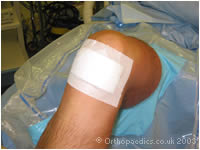


Bristol Knee Clinic

| + home | |
| + news | |
| + research | |
| + patient information | |
| + the clinic | |
| + the surgeon | |
| + sport physiotherapy | |
| + sports advice | |
| + medico legal | |
| + products | |
| + resources | |
| + contact | |
| + maps | |
| + directions | |
| + site map |
The Bristol Knee Clinic |
Anterior Cruciate Ligament Reconstruction - ACL - Surgery
Exercises and Medication Prior to Surgery
Prior to surgery and post operatively it is important to strengthen the muscles of the leg and to reduce the stiffness. Regular exercises should be undertaken to do this. Static quadriceps exercises consist of tensing the muscle on the front of the thigh whilst the knee is straight. Hold the contraction for 5 to 10 seconds, rest for 5 or 10 seconds and begin again. This should be repeated 10-50 times. Whilst lying on your back the straight leg should be lifted into the air and held for 5 to 10 seconds, then lowered rested for 5 to 10 seconds and repeated 10 to 50 times. If possible these exercises should be undertaken against weight or resistance or in a gym using exercise equipment.
Anti-inflammatory tablets (Indomethacin, Voltarol, Brufen, Naprosyn etc) must be stopped 2 days before surgery. On the morning of surgery patients should fast from midnight and arrive at the hospital at 7.20 am. For afternoon surgery you will be fasted after 8 a.m. Prior to the operation any tablets or medications you take, or allergies you may have to medications, should be brought to the attention of the surgeon. Please notify your surgeon and anaesthetist in advance if you are taking any anti-coagulants (blood thinners), hormone replacement tablets, the Pill or suffer from diabetes or any other significant medical condition.
Surgical Technique
The anaesthetist and Mr. Johnson will see you before surgery. The operation is performed under spinal or general anaesthesia. There will be one or two small incisions in the front of the knee either side of the patellar tendon. Two small screws are usually used to anchor the ligament in the bone tunnels. Mr. Johnson usually currently use third generation dissolving poly-lactic acid / tri-calcium phosphate screws. These usually dissolve over a period of three years and do not usually require removal. Following the operation patients usually wake up with a brace on the leg and a continuous passive motion machine that is designed to gently move the knee even while you are asleep. This is used to maintain a range of mobility in the joint to speed your recovery. A removable knee splint may be used to support the knee during the recovery period.

The aim of reconstruction of the anterior cruciate ligament (ACL) is to replace the damaged ligament with a graft that reproduces the features and stability provided by the anterior cruciate ligament. The method employed is to take from the patients own body a piece of tendon of similar size and strength to the ACL and fix it within the knee joint in the same position as the old ACL. The use of artificial ligaments is not as successful. The middle third portion of the patella tendon between the kneecap and the tibia with an attached piece of bone at each end is the available structure which results in the best success rate and return to sports (Regeneration occurs at the site from which the graft is taken). Alternately hamstring tendons can be harvested from the muscles at the back of the knee. The technique of ACL reconstruction, developed in 1990, is continually being improved and adjusted based on experience and research. The procedure should be undertaken arthroscopically through keyhole surgery involving two small 6mm holes in the front of the knee. Arthroscopic ACL reconstruction results in less post operative pain, more accurate placement of the graft in the knee, deals with other problems in the knee, allows a more rapid and successful recovery of movement and function.
The arthroscopic technique involves making drill holes through the tibia into the knee joint, and from inside the joint into the femur. The graft is then passed through these holes so that it lies in the correct position through the joint. The graft is then secured at each end with a screw.It should also be emphasized that at the time of arthroscopy additional damage may be found to the cartilages or joint surface. An additional procedure may be undertaken to correct this and this can usually be done simultaneously without the need for a second operation.
Wound Dressing and Sutures


The crepe bandage, which is applied in theatre, may be removed the following day and replaced by a tubigrip bandage. The dressings may be changed at the same time and on alternate days thereafter. The sutures are usually of the type which dissolve naturally. However sometimes other sutures are used which the general practitioner or practice nurse should remove after 10 - 14 days. Sometimes arrangements are made to return directly to the hospital for this. The wound if dry and the sutures have been removed or dissolved then the wound can be washed, and pool exercises can be begun. If the wound becomes red, inflamed or infected then patients should return to see Mr Johnson.
< BACK to Non-operative Treatment | NEXT: Recovery and Rehabilitation >
Related Links..
+ How to make an appointment
+ Anterior Cruciate Ligament Reconstruction - see all links
+ Patient Information Home
+ See the clinic
+ More about Mr Johnson
+ top
© The Bristol Orthopaedics and Sports Injuries Clinic 2003. The Bristol Knee Clinic is a trading name of the Bristol Orthopaedic Clinic Ltd. privacy / copyright | contact | Powered By Create Medical



